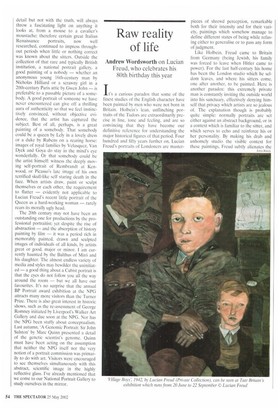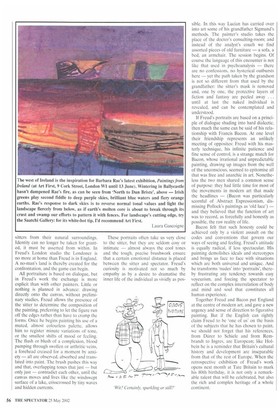Raw reality of life
Andrew Wordsworth on Lucian Freud, who celebrates his 80th birthday this year
It's a curious paradox that some of the finest studies of the English character have been painted by men who were not born in Britain. Holbein's lean, unflinching portraits of the Tudors are extraordinarily precise in line, tone and feeling, and are so convincing that they have become our definitive reference for understanding the major historical figures of that period. Four hundred and fifty years further on, Lucian Freud's portraits of Londoners are master
pieces of shrewd perception, remarkable both for their intensity and for their variety, paintings which somehow manage to define different states of being while refusing either to generalise or to pass any form of judgment.
Like Holbein, Freud came to Britain from Germany (being Jewish, his family was forced to leave when Hitler came to power). For the last half-century his home has been the London studio which he seldom leaves, and where his sitters come, one after another, to be painted. Here is another paradox: this extremely private man is constantly inviting the outside world into his sanctuary, effectively denying himself that privacy which artists are so jealous of. The explanation though is probably quite simple: normally portraits are set either against an abstract background, or in a context which is familiar to the sitter, and which serves to echo and reinforce his or her personality. By making his drab and unhomely studio the visible context for these paintings, Freud subtly alienates the sitters from their natural surroundings. Identity can no longer be taken for granted, it must be asserted from within. In Freud's London studio the Londoner is no more at home than Freud is in England. A no-man's land is thereby created for the confrontation, and the game can begin.
All portraiture is based on dialogue, but in Freud's work the exchange is more explicit than with other painters. Little or nothing is planned in advance: drawing directly onto the canvas, without preliminary studies, Freud allows the presence of the sitter to determine the composition of the painting, preferring to let the figure run off the edges rather than have to cramp the forms. Once he begins painting his use of a muted, almost colourless palette, allows him to register minute variations of tone, or the smallest shifts of mood or feeling. The flush or blush of a complexion, blood pumping through swollen or arthritic veins, a forehead creased for a moment by anxiety — all are observed, absorbed and translated into paint. The brush pushes this way and that, overlapping tones that just — but only just — contradict each other, until the canvas moves and lives like the windswept surface of a lake, crisscrossed by tiny waves and hidden currents. These portraits often take us very close to the sitter, but they are seldom cosy or intimate — almost always the cool tones and the tough, precise brushwork ensure that a certain emotional distance is placed between the sitter and spectator. Freud's curiosity is motivated not so much by empathy as by a desire to dramatise the inner life of the individual as vividly as pos
sible. In this way Lucian has carried over into art some of his grandfather Sigmund's methods. The painter's studio takes the place of the doctor's consulting-room; and instead of the analyst's couch we find assorted pieces of old furniture — a sofa, a bed, an armchair. The session begins. Of course the language of this encounter is not like that used in psychoanalysis — there are no confessions, no hysterical outbursts here — yet the path taken by the grandson is not so different from that used by the grandfather: the sitter's mask is removed and, one by one, the protective layers of fiction and fantasy are peeled away . . . until at last the naked individual is revealed, and can be contemplated and understood.
If Freud's portraits are based on a principle of dialogue shading into hard dialectic, then much the same can be said of his relationship with Francis Bacon. At one level their friendship represents an unlikely meeting of opposites: Freud with his masterly technique, his infinite patience and fine sense of control, is a strange match for Bacon, whose irrational and unpredictable painting, drawing up images from the well of the unconscious, seemed to epitomise all that was free and anarchic in art. Nonetheless the two men shared a common sense of purpose: they had little time for most of the movements in modern art that made the headlines — (Bacon was particularly scornful of Abstract Expressionism, dismissing Pollock's paintings as 'old lace') — and they believed that the function of art was to record, as forcefully and honestly as possible, the raw reality of life.
Bacon felt that such honesty could be achieved only by a violent assault on the codes and conventions that govern our ways of seeing and feeling. Freud's attitude is equally radical, if less spectacular. His painting demolishes ideals and stereotypes and brings us face to face with situations which are both universal and unique. And he transforms 'nudes' into 'portraits', thereby frustrating any tendency towards easy voyeurism, and forcing the spectator to reflect on the complex interrelation of body and mind and soul that constitutes all human experience.
Together Freud and Bacon put England at the centre of modern art, and gave a new urgency and sense of direction to figurative painting. But if the English can rightly claim Freud to be 'one of us' on the basis of the subjects that he has chosen to paint, we should not forget that his references, from DUrer to Schiele and from Rembrandt to Ingres, are European; like Holbein he is a reminder that Britain's cultural history and development are inseparable from that of the rest of Europe. When the retrospective exhibition of Freud's work opens next month at Tate Britain to mark his 80th birthday, it is not only a remarkable talent that will be celebrated, but also the rich and complex heritage of a whole continent.























































































 Previous page
Previous page